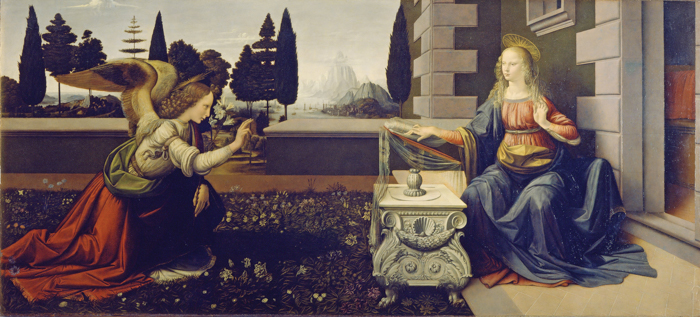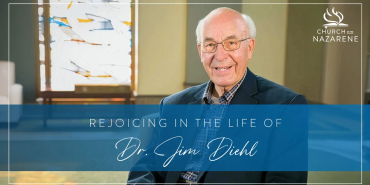Painted Feast Days of the Liturgical Year in Renaissance Florence

Over ten million tourists visited the city of Florence, Italy, in 2017, solidifying its status as one of the most popular travel destinations. Visitors covet tickets to the Galleria degli Uffizi to view works by Botticelli and Leonardo, the Galleria dell’Accademia to wonder at Michelangelo’s colossal David, and the various churches housing the works of Fra Angelico, Donatello and Masaccio. These tourists become students of Renaissance art and visit all times of the year making the Uffizi the most frequented museum in all of Italy. Have they ever wondered how the works of art studied at the Uffizi Gallery or Accademia Museum originally functioned in churches for holidays and during the liturgical seasons of the year?
Florence, the birthplace of the Renaissance in the fourteenth and fifteenth centuries, possessed a community of great minds working in painting, sculpture, and architecture as well as philosophy, poetry, and literature. A large percentage of these artists were practicing Catholics, most of whom attended Mass daily. They would often receive commissions for altarpieces related to the feast days of saints and holy days. This essay focuses on several Renaissance pictures (painted between 1423-1569) that correspond with the liturgical seasons of the church as celebrated, sometimes in a unique way, by Florentines.
The recently restored Annunciation (Fig. 1) by Leonardo da Vinci (1452-1519) has been reinstalled beautifully in the Uffizi. Until 1750, the beginning of the new year in Florence corresponded directly to the Feast of the Annunciation on March 25. Leonardo’s Annunciation, commissioned for the monastery of Monte Oliveto just outside of Florence, depicts the initial moment of encounter between Gabriel and Mary, when Gabriel announced to Mary that she would conceive and give birth to a son, who she was to call Jesus (Luke 1:31).
 [Fig. 1]
[Fig. 1]
Mary is seated behind a lectern, on which rests a book whose fluttering pages (presumably stirred by the rush of Gabriel’s arrival) are stilled by Mary’s fingers. The 13th-century Meditations on the Life of Christ (written by a Franciscan monk in Tuscany) suggests that at the moment Gabriel appeared, Mary may have been reading Isaiah 7:14, a passage traditionally understood as a prophecy of the virginal birth. The lily that Gabriel holds is a symbol of Mary’s purity.
Several scenes related to the birth of Christ appear frequently in Florentine Renaissance art. The Nativity characteristically includes the Christ Child, Mary, and Joseph, with the ox and ass in front of a stable (depicted in various forms). The adoration of the shepherds (a gospel story unique to Luke) was a very popular theme north of the Alps in the fifteenth century.
Domenico Ghirlandaio (1448-1494), the head of the leading workshop in Florence, painted the Adoration of the Shepherds (Fig. 2) for Francesco Sassetti’s family chapel located to the right of the main altar in Santa Trinità on Via Tornabuoni in Florence where it remains today.
 [Fig. 2]
[Fig. 2]
The birth of the Messiah, according to the Gospel of Luke, has the power to lift up the lowly, the despised and the violent (1:52). The occupation of shepherds may have conjured up an image of a despised, and potentially violent group (see Josephus, Jewish War). However, by their actions these rustic shepherds align themselves with a more positive portrayal of the good shepherd—an image evoked by the mention of the city of David. David, of course, was himself a shepherd before becoming king.
David had become a civic symbol for Florence (who often considered itself the successful underdog to the more powerful Papacy and cities of Siena and Pisa).
The Florentine favored the Epiphany scene of the Adoration of the Magi because in Renaissance Florence, Epiphany was celebrated on the same day (January 6) as the baptism of Christ, which was significant because John the Baptist was the patron saint of the city. Many men were also part of a confraternal organization dedicated to the Magi. In 1423, Gentile da Fabriano (1385-1427) painted the Adoration of the Magi (Fig. 3) for Palla Strozzi, a powerful banker.
 [Fig. 3]
[Fig. 3]
Like Francesco Sassetti above, Strozzi was a member of the church of Santa Trintà. This altarpiece was commissioned for his family burial chapel in the sacristy. Gentile was known to combine the naturalism of the Early Renaissance with an elegant, refined drapery style and meticulous attention to detail. The oldest Magus prostrates himself before the Christ child, who lovingly touches his balding head.
The second Magus lifts his right hand to remove his crown out of respect for the child, and the youngest Magus stands waiting patiently for his opportunity to present a gift to Jesus. In the distance, the Magi entourage can be seen returning to their country by another route after being warned in a dream not to go back to Herod (Matt 2:12).
As stated above, Saint John the Baptist is the patron saint of Florence and the baptism of Christ is celebrated on January 6 along with the Epiphany.
John’s personal feast day is June 24, which today remains a major feast day with various religious and social events throughout the city. Businesses are closed. John’s baptizing of Christ signifies the beginning of Jesus’ public ministry.
A Late Renaissance (also known as Mannerism) painter, Michele Tosini (1503-1577) painted Baptism of Christ and Temptations in 1565 at the height of his career in Florence (Fig. 4). Tosini, also known as Michele di Ridolfo del Ghirlandaio, had become the head of the Ghirlandaio workshop mentioned above. This work combines the baptism of Jesus (Luke 3:21) with the three temptations of Christ (Luke 4:1-9).
 [Fig. 4]
[Fig. 4]
John the Baptist is depicted wearing the hairshirt, his iconographic attribute representing his penitential time in the wilderness. The temptations should be read in a counterclockwise direction. The temptation to turn stones into bread, on the right, shows a hunched-over devil in discussion with an attentive Christ. “Command these stones be made bread,” the tempter says to Christ. The devil leads Christ up to a mountain in the second temptation and shows him all the kingdoms of the word.
In the third temptation, Christ and the devil stand on top of the dome of the Temple in Jerusalem, and the devil suggests that Christ throw himself down off the mountain and be protected by the angels.
The fifteenth and sixteenth centuries produced an extraordinary amount of religious works. The paintings discussed indicate the subtle emphases placed on several liturgical seasons and valued feast days as understood by Florentines during this high point in their city’s cultural production.
Heidi J. Hornik is professor of Italian Renaissance Art History at Baylor University in Waco, Texas, USA.
Holiness Today, Nov/Dec 2018
Please note: This article was originally published in 2018. All facts, figures, and titles were accurate to the best of our knowledge at that time but may have since changed.




